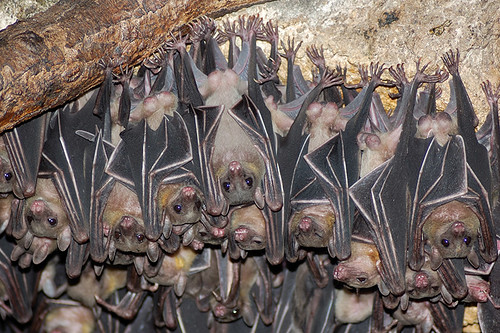#SciDoom The summer of 1918 heralded the arrival of the now infamous strain of influenza virus known from here on as the 'spanish flu' in which 6% of the world's human population succumbed to its deadly form of pneumonia. That particular virus outbreak swept across the world and did it's damage over a single year before abruptly ending it's reign of terror just as quickly as it started.
 |
| In the heat of the 'swine 'flu' epidemic. Will a virus wipe us out or can we stop it before it does it? http://news.bbc.co.uk/ |
The same thing may well have happened across either in Asia or Africa when the smallpox virus first emerged into the human population, only to end up killing 500 million people in the 20th century alone. And to show that this is not some strange quirk of the past - just google virus outbreak and you'll be bombarded with the recent problems with Hendra virus outbreaks in Western Australia. Viruses have had - and always will have - the ability to cause serious damage and with that comes the power to cause some serious fear.
Nothing, I don't think, will ever change that.
 |
| Ebola - virus from the forest. http://en.ird.fr/ |
The real question then comes down to - are we doomed when it comes to these viruses? Will a virus eventually appear that will kill off the entire human race? How likely is it that some as yet unknown virus will emerge from a tropical rainforest somewhere and end up wiping us out?
What I think the answer to this is that we just don't know and we cannot say yet BUT we are in a better position nowadays than we have ever been and this in itself is cause to be optimistic.
3 reasons why I believe what I believe:
- We understand a lot more about viruses than we did 50 or 100 years ago - just look at the sheer amount of work that has been published in the last decade (even if all of it isn't worldclass, ground-breaking stuff). Researchers have discovered the many mechanisms that viruses employ to enter our bodies and gain access to our cells; we know how they spread within the body and we are constantly investigating how they cause disease and illness. This is all with a goal of eventually preventing it through the exploitation of our new-found knowledge. Decades ago, people were not able to do the kind of research we are now carrying out daily in the lab and I predict that this will even get better in next couple of years
- Many new vaccines are being developed and tested in a clinical setting every year with an aim to eradicate or at least seriously reduce the number of those particular viral infections. Just look at what has happened with HPV vaccine, chickenpox, parainfluenza viruses and even consider the historical prowess of the measles, mumps and rubella vaccine. We have also officially wiped out rinderpest virus - a major killer of cattle worldwide. These viruses will definitely not starve us. On top of the developments in vaccine generation - lot of research is throwing back very positive results concerning new antiviral molecules that may show great potential.
- We are even trying to outsmart the viruses at their own game of emergence by attempting to detect them early on and hopefully prevent them from spreading any further than that small focal point of infection. Groups like that led by Nathan Wolfe (and others - see the Emerging Infectious Diseases Journal) have been spending years in sub-Saharan Africa, in the rainforests of the Congo Basin, trying to see what viruses lurk in the animals living there. We do not want another HIV, ebola or indeed Hendra/nipah occurring again without us knowing about it first.
But sadly, its not all great in the world of virology research. Each one of the above points has a number of disclaimers or nasty examples where we haven't really made all that much progress:
- Clearly the last 50 years of molecular virology hasn't yet really proved it's worth, as it is pretty difficult to effectively convert that kind of knowledge into a clinical setting. Not every standard university research group has the ability - or the money - to fund a large clinical trial against their particular candidate drug target.
- A number of viruses we have completely sucked at developing any vaccines at all for. And even when we do develop them, the make things even worse.
- No matter how many people you have looking for viruses out there, I can assure you there are more viruses than people so we all know who is gonna win that one.
But, as I said before, we are in a hell of a better position than we were in 1918 when that spanish flu struck the world. Look at what happened with the SARS outbreak or avian/swine-influenza - we have developed a great global protection system that can prevent these viruses.
So, are we doomed?
I cannot say and I don't think anybody really can either - that is with reference to viruses.




















































